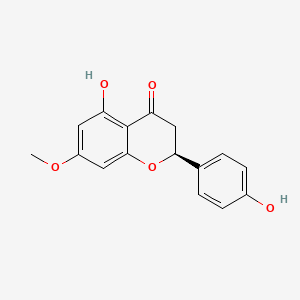| MeSH term | MeSH ID | Detail |
|---|---|---|
| Acne Vulgaris | D000152 | 35 associated lipids |
Sakuranetin
Sakuranetin is a lipid of Polyketides (PK) class. Sakuranetin is associated with abnormalities such as and Neurodegenerative Disorders. The involved functions are known as inhibitors, Drug Interactions, aldehyde reductase activity, Antiinflammatory Effect and antagonists. Sakuranetin often locates in Vacuole and Cell surface. The associated genes with Sakuranetin are PTPN1 gene.
Cross Reference
Introduction
To understand associated biological information of Sakuranetin, we collected biological information of abnormalities, associated pathways, cellular/molecular locations, biological functions, related genes/proteins, lipids and common seen animal/experimental models with organized paragraphs from literatures.
What diseases are associated with Sakuranetin?
Sakuranetin is suspected in Neurodegenerative Disorders and other diseases in descending order of the highest number of associated sentences.
Related references are mostly published in these journals:
| Disease | Cross reference | Weighted score | Related literature |
|---|
Possible diseases from mapped MeSH terms on references
We collected disease MeSH terms mapped to the references associated with Sakuranetin
PubChem Associated disorders and diseases
What pathways are associated with Sakuranetin
There are no associated biomedical information in the current reference collection.
PubChem Biomolecular Interactions and Pathways
Link to PubChem Biomolecular Interactions and PathwaysWhat cellular locations are associated with Sakuranetin?
Visualization in cellular structure
Associated locations are in red color. Not associated locations are in black.
Related references are published most in these journals:
| Location | Cross reference | Weighted score | Related literatures |
|---|
What functions are associated with Sakuranetin?
Related references are published most in these journals:
| Function | Cross reference | Weighted score | Related literatures |
|---|
What lipids are associated with Sakuranetin?
There are no associated biomedical information in the current reference collection.
What genes are associated with Sakuranetin?
Related references are published most in these journals:
| Gene | Cross reference | Weighted score | Related literatures |
|---|
What common seen animal models are associated with Sakuranetin?
There are no associated biomedical information in the current reference collection.
NCBI Entrez Crosslinks
All references with Sakuranetin
Download all related citations| Authors | Title | Published | Journal | PubMed Link |
|---|---|---|---|---|
| Nakazato Y et al. | Methionine-induced phytoalexin production in rice leaves. | 2000 | Biosci. Biotechnol. Biochem. | pmid:10803956 |
| Yamane H | Biosynthesis of phytoalexins and regulatory mechanisms of it in rice. | 2013 | Biosci. Biotechnol. Biochem. | pmid:23748776 |
| Toledo AC et al. | Flavonone treatment reverses airway inflammation and remodelling in an asthma murine model. | 2013 | Br. J. Pharmacol. | pmid:23170811 |
| Kwon C et al. | Enantioseparation of some chiral flavanones using microbial cyclic beta-(1-->3),(1-->6)-glucans as novel chiral additives in capillary electrophoresis. | 2007 | Carbohydr. Res. | pmid:17234165 |
| Katsumata S et al. | Identification of Sternbin and Naringenin as Detoxified Metabolites from the Rice Flavanone Phytoalexin Sakuranetin by Pyricularia oryzae. | 2017 | Chem. Biodivers. | pmid:27647729 |
| Ogawa Y et al. | Allergy-preventive flavonoids from Xanthorrhoea hastilis. | 2007 | Chem. Pharm. Bull. | pmid:17409571 |
| Ibrahim AR et al. | O-demethylation and sulfation of 7-methoxylated flavanones by Cunninghamella elegans. | 2003 | Chem. Pharm. Bull. | pmid:12576658 |
| Yamashita Y et al. | Simple Synthesis of Sakuranetin and Selinone via a Common Intermediate, Utilizing Complementary Regioselectivity in the Deacetylation of Naringenin Triacetate. | 2016 | Chem. Pharm. Bull. | pmid:27373654 |
| Molnár J et al. | Reversal of multidrug resitance by natural substances from plants. | 2010 | Curr Top Med Chem | pmid:20645919 |
| Hong L and Ying SH | Ethanol extract and isolated constituents from artemisia dracunculus inhibit esophageal squamous cell carcinoma and induce apoptotic cell death. | 2015 | Drug Res (Stuttg) | pmid:25076224 |
